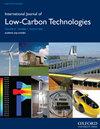Diurnal Characterization of the Atmospheric Urban Heat Island over Urban Hot Agglomerations
IF 2.3
4区 工程技术
Q3 ENERGY & FUELS
引用次数: 0
Abstract
The urban heat island (UHI) is a physical climatic phenomenon, its effects in the built-up areas can be observed in terms of air temperatures above the atmosphere, as well as in terms of thermal comfort under the urban canopy. This study aims to carry out a diurnal characterization of the atmospheric urban heat island over the agglomeration of Guelma, Algeria during summertime. The characterization is organized into three main steps. First, quantifying the UHI intensity. Second, highlighting the factors contributing to affect the thermal environment in downtown Guelma and fianly, defining an appropriate scale to measure it over Gualma’s agglomeration of Guelma. The UHI quantification was done by calculating the positive differences of urban temperatures in daytime based on in-situ approach and static approach. The results indicate that the maximum daily difference reached 4.8°C to 5.1°C with a positive difference of 6.1° at 10:00 a.m. and 6.4°C at noon, which means that Guelma’s agglomeration is affected by the atmospheric urban heat island phenomenon. Depending on the difference of urban temperatures, we have defined appropriate scale to quantify the intensity of UHI phenomenon over Guelma’s agglomeration: ${UHI}_{intensity}=0.3688\vectimes \Delta {T}_{\boldsymbol{urb}}+3.3157.$城市热点地区大气城市热岛的日特征
城市热岛(UHI)是一种物理气候现象,其在建成区的影响可以通过大气以上的空气温度以及城市树冠下的热舒适来观察。本研究的目的是开展大气城市热岛的日特征在Guelma,阿尔及利亚在夏季聚集。描述分为三个主要步骤。首先,量化UHI强度。其次,重点分析了影响盖尔马市区热环境的因素,最后,定义了适宜的尺度,对盖尔马市区的热环境进行了测量。利用原位法和静态法计算城市白天气温正差值,对城市热岛指数进行量化。结果表明:日差最大可达4.8 ~ 5.1℃,上午10时正差6.1℃,中午正差6.4℃,表明圭尔马集聚受到大气城市热岛现象的影响;根据城市温度的差异,我们定义了适当的尺度来量化Guelma城市群的热岛现象强度: ${UHI}_{intensity}=0.3688\vectimes \Delta {T}_{\boldsymbol{urb}}+3.3157.$
本文章由计算机程序翻译,如有差异,请以英文原文为准。
求助全文
约1分钟内获得全文
求助全文
来源期刊

International Journal of Low-carbon Technologies
Engineering-Architecture
CiteScore
4.30
自引率
4.30%
发文量
106
审稿时长
27 weeks
期刊介绍:
The International Journal of Low-Carbon Technologies is a quarterly publication concerned with the challenge of climate change and its effects on the built environment and sustainability. The Journal publishes original, quality research papers on issues of climate change, sustainable development and the built environment related to architecture, building services engineering, civil engineering, building engineering, urban design and other disciplines. It features in-depth articles, technical notes, review papers, book reviews and special issues devoted to international conferences. The journal encourages submissions related to interdisciplinary research in the built environment. The journal is available in paper and electronic formats. All articles are peer-reviewed by leading experts in the field.
 求助内容:
求助内容: 应助结果提醒方式:
应助结果提醒方式:


